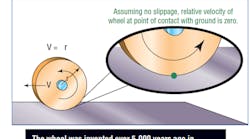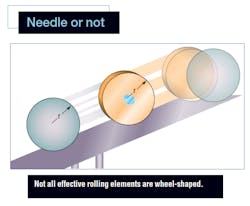The less work required to translate an object, the better. Avoiding sliding friction — a major sinkhole of applied force for motion — is accomplished through rolling.
The linear distance a rolling wheel traverses depends on two factors: its rotational displacement and its radius, as governed by the equation D = u x r, where u is rotational displacement in radians.
Questions & answers
Q: How is a wheel made more efficient?
A: Ironically, with increased friction at the rolling contact surface. Wheels need maximum friction (or minimum slippage) with contact surfaces to work effectively. Designs that get closest to no-slip conditions are gear and chainsprocket designs. Positive mechanical engagement of the teeth raises the efficiency of power transmission. Frictiondrive mechanisms, such as toothless belts on wheel pulleys and wheels with rubberized outer races (such as tires on automobiles) mitigate slipping through increased friction between contact surfaces.
Q: Why is friction sometimes reduced?
A: Smoothing all surfaces in friction-reduction mechanisms (such as a bearing wheel) plays a critical role not only in how well the wheel negotiates the load it bears, but also its efficiency in converting rotational speed and energy into rectilinear motion. When used in conjunction with a stationary axle, needle bearing components of interest include outer and inner races, and friction-reducing rollers. The outer race contacts the work surface, while the inner race remains anchored to the stationary axle that secures the wheel to the system; the rollers act as the friction-reducing element between inner and outer races. This fully engineered system makes for smoother motion.
A: Magnetic levitation is one alternative. Mainly developed for locomotives, magnetic levitation draws upon the power of magnetism for its near-zero friction properties; magnetic fields of the same polarity oppose one another, and the repulsion force generated by these fields acts as the frictionreducing mechanism. With no intimate physical contact between any surfaces, friction is thereby nullified. The major drawbacks of magnetic levitation are that it limits travel to places where tracks can be installed, and its high cost.
Information provided by Ariel C. Oriel, Applications Engineer at Bishop-Wisecarver Corp. in Pittsburg, Calif.


